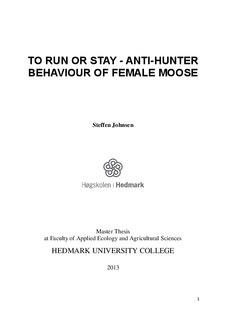To run or stay : anti-hunter behaviour of female moose
Master thesis
Permanent lenke
http://hdl.handle.net/11250/132247Utgivelsesdato
2013Metadata
Vis full innførselSamlinger
Sammendrag
In Norway, hunting is the main mortality factor of moose (Alces alces), with hunters killing approximately ¼ of the fall population each year. During 2009 and 2010 I studied escape behaviour of GPS/VHF-marked female moose when disturbed by humans, using 2 different methods: 1) Observing the hourly movements of individual moose in June when calving status was checked and during the hunting season while stalked by my hunting team; 2) Comparing the daily movements of GPS–moose during the hunting season in hunting units with and without hunters. During calf checking, no female moose defended her calf by aggressive behaviour; instead, the cows moved off, covering a mean distance of 1364 m (min: 117 m, max: 7326 m) before settling down after 2 hours. This indicated that human activity in the forest during the calving season involved little risk for either calves or humans. When flushed during the hunting season, the cows moved a significantly longer distance (mean 2338 m, min: 111 m, max: 6879 m). There were large differences within and between individuals in how far they moved when flushed. Again, no individuals showed aggressive behaviour. Some consistently fled a short distance, some always a long distance, and some were inconsistent, but flight distance was unrelated to survival during the hunting season. The distances cows moved decreased during the hunting season, regardless of disturbance. When hunters were present in a hunting unit, the daily movements of moose cows within the unit increased by an average factor of 1.16 and the percentage of moose moving more than the expected upper daily travel distance increased from 10 to 16.5 %. Although most moose will be shot sooner or later, the probability of a moose being killed when observing a human was low. Some moose were able to sneak around the observer, but most fled a distance sufficient to move out of a hunting unit of mean size 13 km2. I suggest that selection by human hunters against standing still and being aggressive may be a reason for the apparent naivety of moose towards recolonizing wolves (Canis lupus) in Scandinavia.
Beskrivelse
Master in applied ecology. Evenstad 2013
